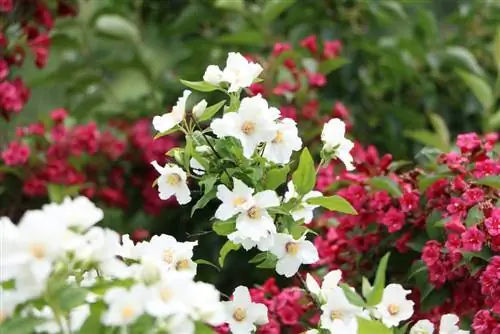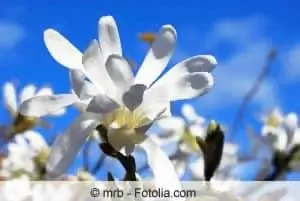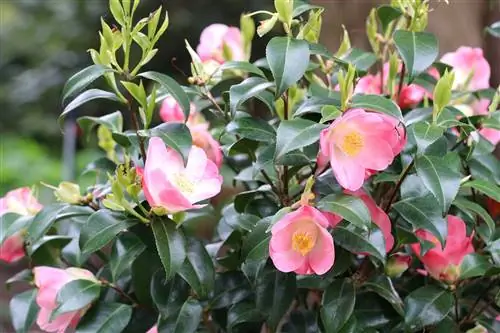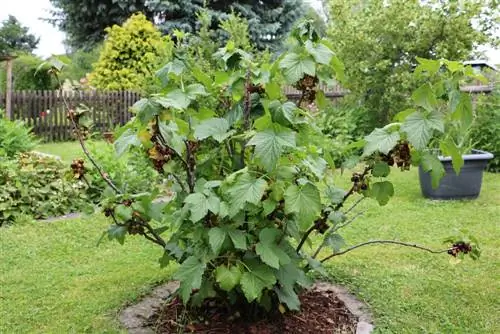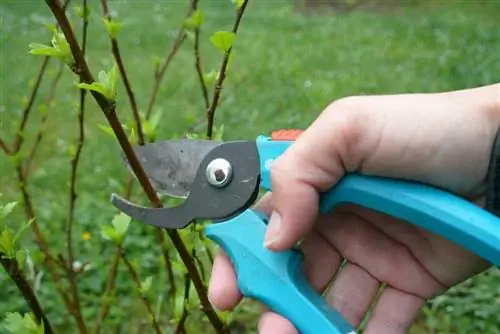- Author admin [email protected].
- Public 2023-12-17 03:39.
- Last modified 2025-06-01 06:48.
The term 'bush' is the colloquial name for a shrub. It has no main trunk, but rather many thin, woody trunks. Bushes can impress in many ways. Be it through their abundance of flowers or magnificent foliage. The dwindling flowers of some species are replaced by edible fruits or decorative berry decorations. Bushes that convince with several arguments become a real eye-catcher.
Best planting time
There is no single best time to plant bushes. In principle, they can be planted in both spring and autumn. In some cases, the planting time can be extended into the summer months, depending on the root packaging. While bare-root goods should be planted by March at the latest, this is possible for baled goods until May and for container goods all year round.
Planting in spring
In spring, when the ground is completely frost-free and no longer too wet, frost-sensitive shrubs or bushes should be purchased and planted, such as hibiscus, hydrangeas or evergreens.
- Plant berry bushes by the end of March if possible
- Planting robust deciduous trees until budding begins in April/May
- For bare-root ornamental shrubs, extend the planting time until mid-May at most
- This early planting allows them to survive the first winter better
- Late planting in autumn, not recommended for these trees
- Planting in spring requires more intensive care
- The plants initially need a lot of water to root
Tip:
Spring is also the best time to move or transplant bushes.
Planting in autumn/winter

Autumn planting is particularly recommended in regions with mild winters and dry summers.
- Shrubs in containers can be planted all year round
- However, planting between September and October is optimal
- Plant bare-rooted bushes ideally from the end of September to April
- Best to buy in autumn and plant in the ground without delay
- Plant evergreen and wintergreen shrubs if possible by the beginning of September
- They retain all or most of their foliage in winter
- They also evaporate water through their leaves in winter
- Consequently they should be well rooted by the onset of winter
With bare-rooted bushes it becomes problematic from May onwards because the fresh shoots cannot be supplied with sufficient water because the roots have not yet grown in properly. Even abundant watering doesn't always help.
Planting shrubs correctly
Soil preparation
Before planting, the soil in the planting area should be prepared accordingly so that the bushes can root well deep in the ground. To do this, the soil should be loosened well down to the deeper layers. Heavy clay soils can be made more permeable by mixing in sand or gravel. In contrast, the structure and storage capacity of sandy soils can be improved with clay or natural clay mineral powder. The plants also thank soil-improving measures such as adding peat, compost or high-quality potting soil with he althy and strong growth.
Planting
To make it easier for the plants to grow in, they should be placed in a water bath for about 10 minutes before planting. In the meantime, a sufficiently large planting hole is dug. A drainage layer made of gravel or grit in the planting hole can protect against waterlogging and soil compaction in the future. Then place the plant in the middle, fill the planting hole with soil and press it down well. To prevent irrigation water from running away, it is advisable to create a watering edge around the plant.
Tip:
In the first few weeks after planting, bushes or shrubs, regardless of type, should be watered depending on the weather.
Fast-growing bushes and shrubs
Fast-growing bushes offer a wide range of design options, be it in groups of plants of the same species such as. B. from different types of rhododendrons or in individual positions. They come into their own particularly well when combined with other species that differ in the shape and color of flowers and leaves or growth habit. The selection of suitable trees is almost inexhaustible.
Flowering bushes
Farmer jasmine 'Philadelphus coronarius'
The farmer's jasmine, also known as the European pipe bush, has a tightly upright and overhanging habit with growth heights of up to 300 cm. The highlight of this undemanding plant are the bright white flowers, which appear from May to June and form an intense contrast to the deep green foliage. Farm jasmine can be used alone, in groups or combined with other trees, for example in a flower hedge. It thrives in sunny and partially shaded locations and in any garden soil.
Mother of pearl bush 'Kolkwitzia amabilis'
The mother-of-pearl bush grows as a dense, spreading bush and is covered in bright pink to red-white and sweet-smelling flower umbels from May to June. Its waterfall-like, overhanging growth appears very graceful, reaching heights of up to 350 cm. This plant is undemanding, easy to care for, shade tolerant and cut tolerant.
Stuffed viburnum - Viburnum opulus ‘Roseum’
The appeal of this plant is its white, double flower balls, which are up to 8 cm large. They stand out from the green leaves and unfold their full splendor with a spectacular long-distance effect from May to June. Sunny locations and moist, well-drained soil are ideal.
Buddleia 'Buddleja davidii'
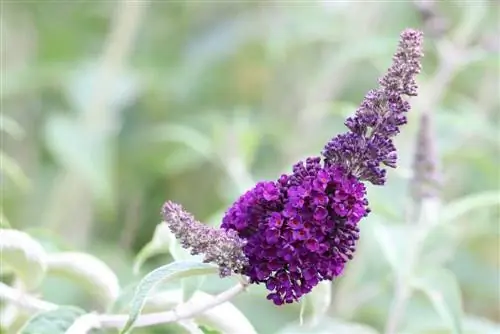
The buddleia, also known as butterfly lilac, grows as a deciduous, evergreen or wintergreen subshrub with numerous cultivars, different flower colors and heights. While the smallest varieties reach a height of around 150 cm, the largest ones reach heights of up to 400 cm. The large white, pink, rose-red, lilac or dark purple flower spikes are a magnet for butterflies. This undemanding and easy-care plant really comes into its own in summer flower beds, full-sunny perennial beds, but also in individual positions.
Marshmallow 'Lavender Chiffon'
This garden marshmallow is a particularly pretty specimen of the hibiscus genus. Its very large, semi-double, violet-pink flowers with a red center catch the eye from afar. Flowering time is from July to September. The flowers exude a tropical flair and form intense contrasts to the egg-shaped, medium green leaves. The growth is bushy, upright, with heights of up to 200 cm. These fast-growing bushes can be cultivated as a solitary plant, in a flowering hedge or as a container plant.
Chestnut Aesculus parviflora
The bush chestnut not only impresses with its 30 cm long, upright white flower panicles from July to August, its foliage is also very attractive. While the shoots are bright red, the leaves later become intense green and golden yellow in autumn. This bushy and sprawling shrub grows up to 400 cm high and looks particularly elegant when placed alone. It is suitable for full sun and half shade and evenly moist soil.
Scented Shrubs
Beardflower 'Heavenly Blue'
This bushy and compact, multi-shooting shrub remains comparatively small with a maximum height of 100 cm. The greatest beauty of this plant are the deep dark blue flowers in the form of umbels, which make this bush shine from August to October. Its leaves, which are green on the top and silver on the bottom, exude an aromatic scent. To thrive, it needs plenty of sun and well-drained, nutrient-rich soil. The beard flower usually dries back a lot in winter, but will sprout again reliably after pruning in spring.
Double Garden Jasmine / Pipe Bush 'Virginal'
This fast-growing, deciduous tree stands out primarily because of its bright white, double flowers. They adorn the bush from the end of May to the beginning of July and exude an intense scent. There may be re-blooming in late summer. These richly flowering bushes can grow up to 300 cm high and 250 cm wide. They are very tolerant when it comes to location and care. As a solitary plant in the middle of a lawn, this garden jasmine is a real eye-catcher, but is also ideal for group planting.
Spice bush 'Calycanthus floridus'
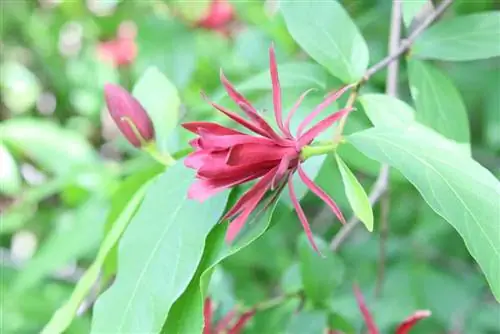
This spice bush makes its big appearance from May until well into summer. Namely when its unusual, brown-red flowers exude their heavy, spicy and far-reaching scent of cloves and strawberries in the evening hours. But not only the flowers, but also the leaves and bark smell of cloves. The Indians already used the flavoring power of this impressive plant, which is up to 300 cm high. It thrives well in sun and partial shade as well as in humus-rich and loose garden soil. It has a spectacular effect when placed alone or in groups, especially in a scented garden.
Spanish broom (Spartium junceum)
Spanish broom, also known as awl or rush broom, is initially noticeable in spring because of its bright yellow flowers, which sit on rod-like stems typical of broom. The highlight of this pretty plant, however, is the sweet, jasmine-like scent that can be noticed from a distance. These deciduous, fast-growing bushes grow up to 300 cm tall under ideal conditions. The dark green, needle-like leaves, up to 50 cm long, are also unusual and beautiful to look at. Spanish broom feels particularly comfortable in the sun.
Fruit bushes
Japanese quince ‘Chaenomeles japonica’
The Japanese ornamental quince is an extremely attractive shrub with an annual growth of up to 30 cm. From March to April it is covered in small brick-red flowers that give any garden an Asian flair. In addition, these bushes produce edible fruits that smell very pleasant. With growth heights of up to 100 cm, they remain rather small, but no less beautiful. Its sparse growth makes it ideal for dense, impenetrable hedges. But it also has an impact when planted alone or in groups, for example with bulbous flowers of different colors.
Black elderberry ‘Haschberg’
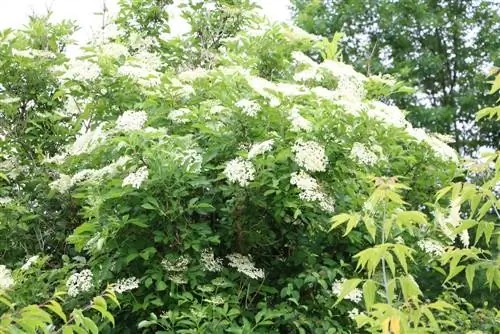
The black elder Sambucus nigra 'Haschberg', also known as the lilac berry, is a vigorously growing bush or shrub up to 400 cm high. The snow-white flower plates appear as early as May and spread a sweet scent. The black fruit umbels follow in early summer and can be harvested from around September. Elderberry loves sunny to partially shaded locations and humus-rich soil. It can be used in a variety of ways in the garden, be it as a fruit or flower plant, in a flower or colorful hedge or simply as a solitary plant.
Common barberry ‘Berberis vulgaris’
The common barberry is a thorny deciduous shrub. It is also known as sour thorn and vinegar berry. From May to June it is adorned with countless bright yellow flowers that stand out clearly from the green foliage. They later develop into the orange-red to dark red, edible fruits that are ready to harvest around October. In autumn, the yellow-orange to bright red autumn leaves are also very decorative. The sour thorn can grow up to 300 cm in height and is otherwise very undemanding.
Purple hazel / blood hazel 'Purpurea' Corylus maxima 'Purpurea'
Among the many fast-growing bushes, the purple hazel should not be missing. The most striking thing about it is the bright red foliage when it sprouts and later a constant black-red color, which does not turn green even in dark locations. The flowers of this medium-tall shrub, small red catkins up to 6 cm long, appear before they sprout. The red-brown nuts can then be harvested in autumn. The hazel can grow up to 300 cm high and requires little in terms of location and care.

